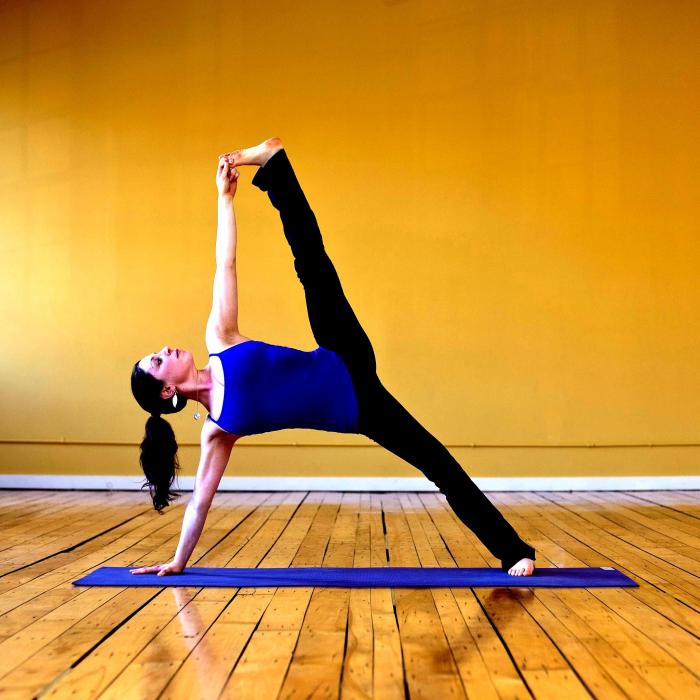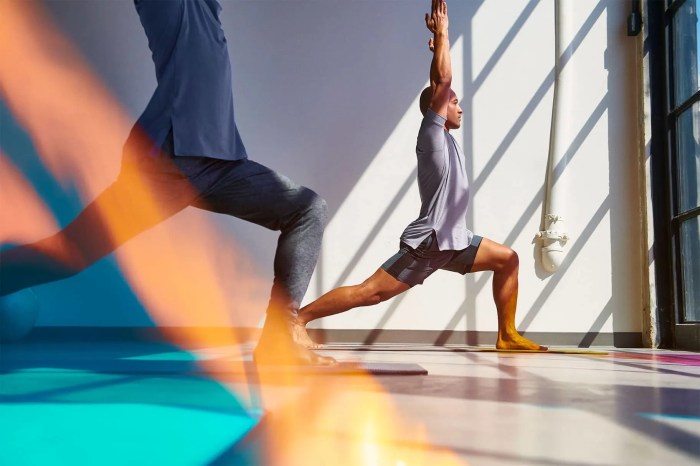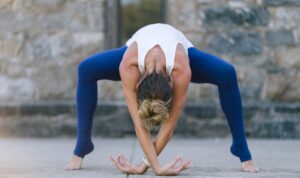Get ready to dive into the world of yoga poses, where mastering proper alignment and technique can unlock a myriad of benefits. From physical strength to mental clarity, each pose holds its own power waiting to be explored.
As we unravel the different types of poses, delve into alignment techniques, and uncover the transformative benefits, you’ll be equipped with the knowledge to elevate your yoga practice to new heights.
Introduction to Yoga Poses
Yoga poses, also known as asanas, are specific physical postures practiced in yoga to promote physical, mental, and spiritual well-being. These poses are an integral part of a yoga practice and are designed to stretch, strengthen, and balance the body.
Benefits of Practicing Yoga Poses
- Improves flexibility and range of motion
- Builds strength and tones muscles
- Enhances balance and coordination
- Promotes relaxation and stress relief
Importance of Proper Form and Alignment
Proper form and alignment in yoga poses are crucial to prevent injuries and maximize the benefits of the practice. By maintaining correct alignment, you can ensure that the intended muscles are being engaged and avoid straining other parts of the body. Remember to listen to your body and make adjustments as needed to find a position that feels comfortable and sustainable.
Types of Yoga Poses
Yoga poses can be categorized into various types based on their physical benefits and the muscles they target. Understanding the different types of yoga poses can help practitioners create a well-rounded practice that addresses various aspects of physical and mental well-being.
Standing Poses
Standing poses are foundational in yoga practice and help improve balance, strength, and flexibility. These poses often require engagement of the core and lower body muscles to maintain stability. Examples include Mountain Pose (Tadasana), Warrior I (Virabhadrasana I), and Tree Pose (Vrikshasana).
Seated Poses
Seated poses are beneficial for improving posture, hip flexibility, and grounding energy. These poses are often practiced towards the end of a yoga session to help calm the mind and prepare for relaxation. Examples include Seated Forward Bend (Paschimottanasana), Bound Angle Pose (Baddha Konasana), and Easy Pose (Sukhasana).
Backbends
Backbends help open the chest, improve spinal flexibility, and counteract the effects of prolonged sitting. These poses can be energizing and invigorating, promoting a sense of openness. Examples include Cobra Pose (Bhujangasana), Upward-Facing Dog (Urdhva Mukha Svanasana), and Bridge Pose (Setu Bandhasana).
Twists
Twists are beneficial for improving spinal mobility, detoxifying the body, and massaging the internal organs. These poses help release tension in the back and promote digestion. Examples include Revolved Chair Pose (Parivrtta Utkatasana), Seated Spinal Twist (Ardha Matsyendrasana), and Revolved Triangle Pose (Parivrtta Trikonasana).
Inversions
Inversions involve poses where the head is positioned below the heart, such as headstands and shoulder stands. These poses help improve circulation, build strength in the upper body, and promote a different perspective. Examples include Headstand (Sirsasana), Handstand (Adho Mukha Vrksasana), and Shoulder Stand (Sarvangasana).
Balancing Poses
Balancing poses challenge the practitioner to find stability and focus, improving concentration and coordination. These poses also strengthen the core and leg muscles. Examples include Tree Pose (Vrikshasana), Warrior III (Virabhadrasana III), and Eagle Pose (Garudasana).
Dynamic vs. Static Poses
Dynamic poses like Sun Salutations (Surya Namaskar) involve continuous movement and flow between poses, creating heat in the body and improving cardiovascular health. On the other hand, static poses like Warrior poses require holding a pose for a longer period, focusing on alignment, strength, and endurance.
Beginner-Friendly vs. Advanced Poses
Beginner-friendly poses are accessible to those new to yoga and focus on building foundational strength, flexibility, and body awareness. Examples include Child’s Pose (Balasana), Downward-Facing Dog (Adho Mukha Svanasana), and Cat-Cow Stretch (Marjaryasana-Bitilasana). Advanced poses challenge practitioners with more complex movements, transitions, and alignment. Examples include King Pigeon Pose (Kapotasana), Flying Pigeon Pose (Eka Pada Galavasana), and Scorpion Pose (Vrschikasana).
Alignment and Technique in Yoga Poses

Maintaining proper alignment in yoga poses is crucial for both safety and effectiveness. Proper alignment helps prevent injuries and allows you to fully experience the benefits of each pose. Here are some tips on how to improve alignment in poses like Downward Dog or Warrior II:
Importance of Alignment
- Alignment ensures that the body is in the correct position to avoid strain on muscles and joints.
- Proper alignment helps in engaging the right muscles and experiencing the intended benefits of the pose.
- Alignment also helps in creating a sense of balance and stability in the pose.
Tips to Improve Alignment
- Focus on your foundation: In poses like Downward Dog, ensure that your hands are shoulder-width apart and feet are hip-width apart to create a solid base.
- Engage core muscles: Activating your core muscles helps in maintaining alignment and stability in poses like Warrior II.
- Align your joints: Pay attention to the alignment of your knees, hips, and shoulders to prevent unnecessary stress on the joints.
Role of Breath and Drishti
- Use your breath to guide movement and maintain alignment. Inhale to lengthen the spine and exhale to deepen the stretch.
- Drishti, or gazing point, helps in focusing the mind and maintaining balance. Fixing your gaze on a specific point can aid in alignment during challenging poses.
- Remember to breathe deeply and stay mindful of your drishti to enhance your practice and maintain proper alignment.
Benefits of Specific Yoga Poses

Yoga poses offer a wide range of benefits for the body and mind, targeting different areas and aspects of health and well-being.
Physical Benefits
- Cobra Pose: Strengthens the back muscles, improves posture, and helps alleviate lower back pain.
- Tree Pose: Enhances balance, stability, and concentration while strengthening the legs and ankles.
Mental Benefits
- Child’s Pose: Promotes relaxation, reduces stress, and calms the mind through deep breathing and introspection.
- Warrior Poses: Boost confidence, inner strength, and courage while improving focus and determination.
Health Conditions
- Downward Dog: Helps relieve symptoms of anxiety, depression, and fatigue by increasing blood flow to the brain.
- Pigeon Pose: Alleviates sciatic pain, hip tension, and improves flexibility in the hips and lower back.
Yoga Pose Sequences
Sequencing poses in a yoga practice is crucial for creating a well-rounded and balanced session. It helps to warm up the body, build strength, improve flexibility, and promote relaxation.
Common Sequences
One of the most popular sequences in yoga is the Sun Salutation, which consists of a series of poses that flow together smoothly. Another common sequence is a morning flow, designed to energize the body and mind for the day ahead.
Creating a Balanced Sequence, Yoga poses
- Start with gentle warm-up poses to prepare the body for more intense postures.
- Incorporate standing poses to build strength and improve balance.
- Add in seated poses to promote flexibility and release tension in the hips and lower back.
- Include inversions and backbends to challenge the body and build confidence.
- End with calming poses and a final relaxation to bring the practice to a close.
Props and Modifications in Yoga Poses
Using props like blocks, straps, and bolsters can greatly enhance or modify yoga poses, making them accessible to everyone regardless of their level of experience or physical limitations.
Benefits of Props in Yoga Poses
- Props help in achieving proper alignment by providing support and stability.
- They can assist in deepening stretches and improving flexibility gradually.
- Props can reduce the risk of injury by allowing practitioners to ease into challenging poses safely.
Modifications for Different Body Types or Flexibility Levels
- For beginners or those with limited flexibility, props can be used to make poses more accessible and comfortable.
- Individuals with physical limitations can use props to adapt poses to their needs without compromising the benefits.
- Modifications can be tailored to different body types, ensuring that everyone can experience the benefits of yoga poses.
